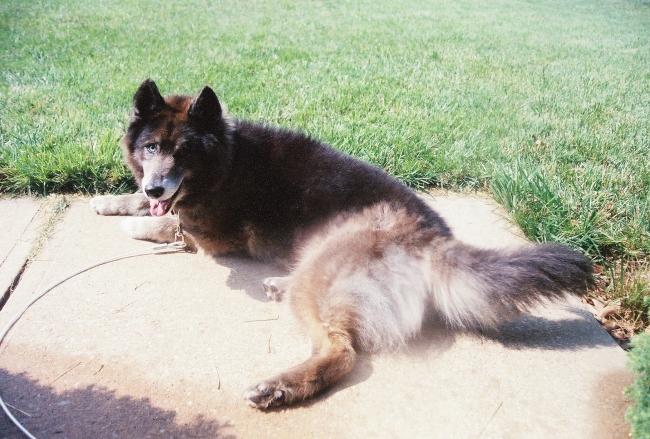Tags
Basic Obedience, Dog, Dogs, Obedience, Pet Obedience, Training
I was a professional dog trainer for years. I concentrated on basic pet obedience and behavior modification, teaching mostly ultra-small classes and doing private work. I’ve never met a dog that I didn’t love, or who couldn’t learn – though some require a lot of positive motivation. (Yes, you sweet big-eyed basset hound, I’m looking at you!)
For many people, an obedience class is a wonderful way to learn. In some cases, it may not be feasible. And if you’ve taught your dogs in the past, you may just need a bit of a brush-up, or a single session to get extra advice.
These days, I advise friends on issues they’re having. I’ve done it by phone and online, as well as in person. I’ve found that phone/internet results can be terrific. It’s all down to good communication.
I recently had another request for advice. In addition to answering privately, I want to share some basics. Here are some things that I like to discuss with new students (the human part of the team, that is).
Dogs are great companions and co-workers, when we teach them what’s appropriate. Most of obedience training is actually our learning how to communicate to get the results we want. Every dog knows how to sit, for example; sitting ‘on command’ and offering us the behavior makes everyone’s life easier. Working with your dog also strengthens the bond between you. We teach dogs using modern, positive behavioral methods. It’s more effective, in addition to being loads more fun for all involved. We teach a dog, in large part, by setting-up the behavior we want, and then rewarding it. There are ‘tricks’ to it, and that’s why there are trainers. Anyone who’s taken an obedience class, or otherwise successfully taught their dog, is a trainer, to my mind. There are a few key things to remember, when you’re teaching your dog, in my opinion. Be patient, be observant, be consistent, and keep your sense of humor. If you’re missing any of those at a given time, wait till you’re feeling more relaxed. There’ll be more about all of this, as we go along.
You don’t have to devote a lot of time to working with your dog. ‘Homework’ averages about 30 minutes a day; you often get the best results by doing a few or several short sessions. At the first sign of fatigue or loss of interest (either yours or the dog’s), end the session. Better yet, stop while you’re both still enjoying it. That way you’ll always be glad to start again the next time. When you’re working on more advanced training, your sessions will be a bit longer, but will always stay in the ‘fun’ category. Most people won’t always have time to keep up with training according to schedule. When that happens, forgive yourself and keep up what you can. You can catch yourself up when your schedule allows.
The Basics of Pet Dog Training
This is a double-entendre. There are the basic commands, or cues. And there are the basics of how we teach. Let’s look at both.
Basic cues are: watch, wait, come, sit, stay, down, loose-leash walking, and heel. All of these, together, contribute to a dog you can take pretty much anywhere. One of them may save your dog’s life, someday. Puppies and some adult dogs also need additional behavior work on issues like jumping-up. This group of cued behaviors can allow you to take your dog nearly anywhere. In addition, it’s integral to your dog learning self-discipline and having a sense of being part of that team I keep mentioning.
You want your dog to learn to respond to these cues the first time you give them, every time, with enthusiasm and reasonable speed. Distractions happen, but consistency is the goal.
What do the cues mean?
Watch: Pay attention! I might ask you to do something at any time.
Wait: This is great for going through doors, gates, etc. As opposed to ‘stay back,’ it means ‘wait your turn; you’re coming too. But I’m going first.’
Come: Be here with me, now. It’s when your dog’s right in front of you that you say ‘good come!’ Coming to you doesn’t do much good if your dog’s not only out of reach, but zooms off again immediately. (see ‘Stay’)
Sit: Plant that bottom firmly on the floor.
Stay: Pretty obvious, this one. We build it into a number of other cues. For instance, ‘come’ is taught with an automatic sit and stay. Taught as an automatic follow-up to sit, and down. I think you get the idea.
Down: Lie down. All the way down.
Loose-leash walking: The cue for this is usually ‘let’s go.’ Obviously, you can personalise the words you use for cues. What this means is walking on leash without pulling. Pulling is bad for your dog’s neck and trachea, and isn’t good teamwork.
Heel: Walk beside me, close. And sit when I stop. This one’s great for going out in public, and can also protect your dog’s safety.
Reminder: all of these cues are taught as fun things. You get terrific results this way.
Watch! An Example of How We Teach a Behavior
This one’s a foundation to everything else you do. It’s all about attention, and if you don’t have your dog’s attention, you can’t count on him/her following a cue.
We start this off in a very low-distraction environment, and increase distractions as your dog gets better at it. If the dog loses concentration, we go back to lower distractions, make sure it’s solid, and then move forward again, gradually. Some trainers use target sticks or clickers to teach this and other cues, but it’s not necessary for most dogs, and handling one more thing can make it more difficult for some of us. Let’s try this without those. You can always add one later, if you have trouble with something or are doing something more advanced and want to use it.
Start off in a quiet room, with something that motivates your dog. A few dogs are so willing to please that all they need is praise and petting. Most will need, initially, treats or a toy to keep their attention. You can start teaching anything using, for instance, treats (with simultaneous praise and petting) and gradually reduce the treats until they’re just an occasional thing.
Let’s say you’re using treats for this. You’ll want a number of very small treats that your dog likes but won’t be fixated about. If your dog likes, for instance, chicken, bacon strips or something, tear them into little pieces ahead of time. Also, you don’t want your dog to be starving, but you won’t get the best results if you practice this right after a meal. If your dog’s bursting with energy, plan on enough playtime before practice that your dog will be calm enough to pay attention.
An easy way to do this exercise is to sit near your dog, treats in hand, and hold one up by your eyes while saying ‘Watch!’ You may prefer to say your dog’s name as the attention cue. Once you have eye contact (or something close to it), immediately give the treat, while saying ‘good watch!’ or ‘good Muffy!’ This speeds your dog’s association with the word, so that learning goes faster. You’ll want to use a calm but happy tone of voice. You can repeated this exercise in rapid succession, for a few minutes. Again, it’s best to stop while it’s going well and you’re both enjoying yourselves. When you’re finished, say ‘all done!’ And you can have a lovely petting session. As you and your dog get better at the exercise, you’ll find you’ll only need the verbal cue, and can cut down on the hand signal and treats, moving to just praise and petting for the desired attention response from your dog. It is useful, though, to have a hand signal for each cue, as well as a word or phrase. In addition, you’ll want to vary the location in which you do the exercise, and your position relative to your dog. This way, the dog will begin to learn to respond in various situations. Take it at your own speed, but your dog may well surprise you with how quickly he/she learns!
If something isn’t working, there’s always a way to tweak it or approach it differently. If you’re having no success at all, stop the exercise and talk to a trainer, or a friend who’s got more experience.
We’ll end here, for now.
If you’ve read this far, thanks! You get a gold star! Constructive feedback is always appreciated!


Have you graduated to children-training now?
Such great need.
You’re right; there is. I have some health issues that keep me from working or, at present, even volunteering. When I give free advice, these days, I usually note that many of the same basic concepts apply to children. I forgot to do that, here. Thanks for the heads-up on that. I think I’ll write a blog about the issue.